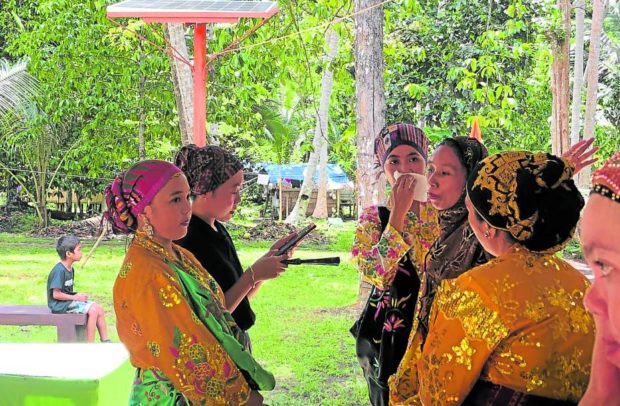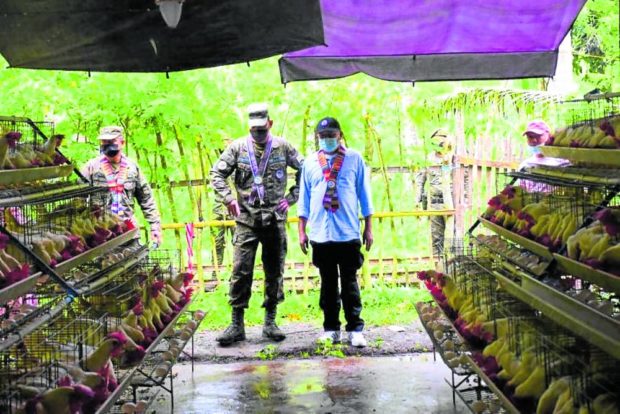From the Philippine Daily Inquirer (Jul 10, 2022): Army winning vs Abu Sayyaf one village at a time (By: Julie S. Alipala)

EXPLOSION OF COLORS | Colorful traditional Tausug dresses are on display as women of Bakong village in Patikul, Sulu, gather on June 17 to mark one year after they returned to the land of their birth. (Photo by JULIE S. ALIPALA / Inquirer Mindanao)
PATIKUL, Sulu, Philippines — Linda Saidul, 67, still remembers the day she and her family fled their village of Bakong here 21 years ago.
“It was dark, and we crawled and ran away from our home,” Saidul recalled.
In the middle of the night, their community was trapped in a fierce clash between government troops and Abu Sayyaf bandits who, at that time, were holding hostages from a high-end resort in Sipadan, Malaysia.
Amid heavy bombardment, Saidul’s family found their way in Kadday Mampallam village, leaving behind a barn full of farm animals — cows, chickens, goats.
“We thought it was just for a few days,” she said. Her family, just like other villagers, has since abandoned the thought of ever setting foot in Bakong again.
But, the military’s success in neutralizing the Abu Sayyaf bandits gave them the opportunity to return to Bakong last year. Today, Saidul runs a mini convenience store that is serving a growing neighborhood, thanks to other villagers who wanted to be back to the land of their birth.
“When I set foot here, I cried hard. I embraced whatever I saw in my place; my barn was already destroyed, wood rotten and my farm animals were all gone. It doesn’t matter now, what’s important is we are all back here again in our own real home,” an emotional Saidul told the Inquirer.
Bakong village chief Hamissa Anuddin, 31, said they discovered that their community had turned into a forest upon their return.
When her family fled in 2000, her uncle, Hamdani, was the village chief who continued to govern while seeking temporary shelter in Barangay Kaunayan, where most of the villagers also evacuated.
By 2013, it was Anuddin’s time to serve the displaced villagers.
In the 2020 national census, Bakong had a population of 739, although they are not physically in their village that they have come to regard through the years as “no man’s land.”

NEW DAWN | A Badjao man sails toward a pier in Jolo, Sulu, early morning to catch the first coin thrown by arriving passengers from Zamboanga City. Peace has begun to dawn in the province as many Abu Sayyaf fighters abandoned banditry, raising fresh hopes of development among locals. (Photo by JULIE S. ALIPALA / Inquirer Mindanao)
Displaced no more
But when the village was opened for the government’s “Balik Barangay” (return to village) program in 2020, 115 mostly young families or close to 500 people surfaced and expressed intent to return, said Anuddin.
Brig. Gen. Benjamin Batara Jr., commander of the Army’s 1103rd Brigade that covers Sulu, credits his predecessor, Brig. Gen. Antonio Nafarrete, for laying the groundwork of the program in 2020.
By returning the families to their old communities and ending their life as displaced people, the military hopes to win against the Abu Sayyaf one village at a time, and constricting the space where the bandits can establish their strongholds.
When he was at the helm of the Western Mindanao Command, then Lt. Gen. Cirilito Sobejana emphasized the equal importance of noncombat initiatives to defeat the Abu Sayyaf.
Helped by personnel from the Army’s community support program in Basilan province, the Sulu-based troops poured their efforts in locating the displaced families and addressing their needs so they can eventually return to their home village.
Instead of combat, the Army busied itself with coordinating for aid, support services, and livelihood training.
Anuddin said each family received P5,000 from the Sulu provincial government to be used for lumber and roofing. They were also given grocery items.
The Ministry of Public Works of the Bangsamoro Autonomous Region in Muslim Mindanao built infrastructure like roads, primary school, mosque, public square-cum-sports field, barangay hall and water system.
The first village to be opened was Bungkaong in 2020. According to Batara, a total of 2,001 families have so far returned to the villages of Bungkaong, Latih, Tugas, Maligay, Kabbon Takkas, Pansul, Bakong, Panglayahan, Sitio Darayan in Buhanginan, and Sitio Bastiong in Langhub, all in Patikul.
In Bud Bunga in Talipao town, an initial 99 families were returned in April last year.
But when the village was opened for the government’s “Balik Barangay” (return to village) program in 2020, 115 mostly young families or close to 500 people surfaced and expressed intent to return, said Anuddin.
Brig. Gen. Benjamin Batara Jr., commander of the Army’s 1103rd Brigade that covers Sulu, credits his predecessor, Brig. Gen. Antonio Nafarrete, for laying the groundwork of the program in 2020.
By returning the families to their old communities and ending their life as displaced people, the military hopes to win against the Abu Sayyaf one village at a time, and constricting the space where the bandits can establish their strongholds.
When he was at the helm of the Western Mindanao Command, then Lt. Gen. Cirilito Sobejana emphasized the equal importance of noncombat initiatives to defeat the Abu Sayyaf.
Helped by personnel from the Army’s community support program in Basilan province, the Sulu-based troops poured their efforts in locating the displaced families and addressing their needs so they can eventually return to their home village.
Instead of combat, the Army busied itself with coordinating for aid, support services, and livelihood training.
Anuddin said each family received P5,000 from the Sulu provincial government to be used for lumber and roofing. They were also given grocery items.
The Ministry of Public Works of the Bangsamoro Autonomous Region in Muslim Mindanao built infrastructure like roads, primary school, mosque, public square-cum-sports field, barangay hall and water system.
The first village to be opened was Bungkaong in 2020. According to Batara, a total of 2,001 families have so far returned to the villages of Bungkaong, Latih, Tugas, Maligay, Kabbon Takkas, Pansul, Bakong, Panglayahan, Sitio Darayan in Buhanginan, and Sitio Bastiong in Langhub, all in Patikul.
In Bud Bunga in Talipao town, an initial 99 families were returned in April last year.

BREAKTHROUGH | Maj. Gen. Ignatius Patrimonio (center), commander of the Army’s 11th Infantry Division, Brig. Gen. Benjamin Batara Jr. (left), commander of the Army’s 1103rd Brigade, and Ministry of Public Works district engineer Ajan Ajijul visit a poultry farm in Barangay Bakong, Patikul. Through the livelihood assistance secured by the residents, 11 villages in Sulu province that underwent the Balik Barangay program are now major suppliers of egg and poultry meat in the province. (Photo courtesy of Civil Military Office, 11th Infantry Division, Philippine Army)
Thriving communities
A year after their return, the residents see their respective communities flourishing.
Within a year, what used to be shacks and huts, people started building their concrete homes with extensions, including shops and sari-sari (variety) stores. Water supply is available to every household and they have solar-powered electricity.
According to Batara, the 11 villages have cooperatives that carry out agricultural production ventures such as egg production and poultry raising. Each barangay, he said, was provided with 1,000 egg-laying chickens.
Since 2020, these communities are major producers of eggs for the province, especially in the towns of Patikul, Jolo and Indanan, Batara added.
To ensure that the communities will be resilient from possible incursion of the Abu Sayyaf, the Army set up patrol bases near the village. In addition, adult males were trained either as civilian militias or members of the Barangay Peacekeeping Action Team.
Batara said they also employed the cooperation of religious leaders to counter extremist thinking through their preaching and Islamic teaching.
Anuddin notes that a number of displaced families scattered all throughout Sulu have expressed their intention to be back in Bakong, seeing the progress they have made within a year.
“It was like a dream. We left in haste and fear. Then we came back to a thick forest. I cannot explain my emotions. This was my father’s dream [although] he failed to witness how his dream materialized. This [returning home] is very important to us as we were born here,” said an emotional Anuddin.
A year after their return, the residents see their respective communities flourishing.
Within a year, what used to be shacks and huts, people started building their concrete homes with extensions, including shops and sari-sari (variety) stores. Water supply is available to every household and they have solar-powered electricity.
According to Batara, the 11 villages have cooperatives that carry out agricultural production ventures such as egg production and poultry raising. Each barangay, he said, was provided with 1,000 egg-laying chickens.
Since 2020, these communities are major producers of eggs for the province, especially in the towns of Patikul, Jolo and Indanan, Batara added.
To ensure that the communities will be resilient from possible incursion of the Abu Sayyaf, the Army set up patrol bases near the village. In addition, adult males were trained either as civilian militias or members of the Barangay Peacekeeping Action Team.
Batara said they also employed the cooperation of religious leaders to counter extremist thinking through their preaching and Islamic teaching.
Anuddin notes that a number of displaced families scattered all throughout Sulu have expressed their intention to be back in Bakong, seeing the progress they have made within a year.
“It was like a dream. We left in haste and fear. Then we came back to a thick forest. I cannot explain my emotions. This was my father’s dream [although] he failed to witness how his dream materialized. This [returning home] is very important to us as we were born here,” said an emotional Anuddin.
https://newsinfo.inquirer.net/1624909/army-winning-vs-abu-sayyaf-one-village-at-a-time

No comments:
Post a Comment
Note: Only a member of this blog may post a comment.